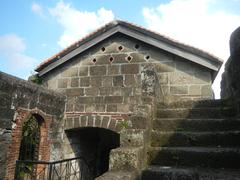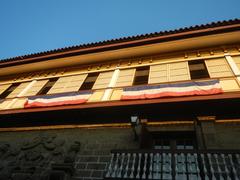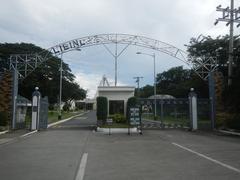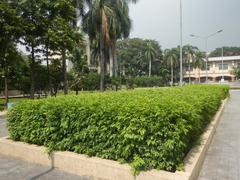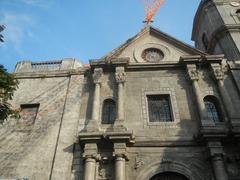Guide to Visiting Fort Santiago, Intramuros, Manila, Philippines
Publication Date: 17/07/2024
Introduction to Fort Santiago
Fort Santiago, located in the historic walled city of Intramuros, Manila, Philippines, is a must-visit destination for history enthusiasts and tourists alike. This iconic fortress, built in 1571 by Spanish conquistador Miguel López de Legazpi, serves as a powerful symbol of the Philippines’ colonial past and its arduous journey towards independence. Named after Saint James the Great, Fort Santiago was originally constructed to defend against foreign invaders and local uprisings. Over the centuries, it has borne witness to critical events in Philippine history, including the Spanish colonial era, the American period, and the Japanese occupation during World War II. Today, Fort Santiago stands not only as a historical monument but also as a vibrant cultural site, offering visitors a glimpse into the rich tapestry of the nation’s heritage. This comprehensive guide aims to provide detailed insights into Fort Santiago’s historical significance, architectural features, and practical visitor information, ensuring a well-rounded and enriching experience for all who explore its storied grounds (National Historical Commission of the Philippines, Intramuros Administration).
Contents Overview
- Introduction to Fort Santiago
- Early Beginnings and Spanish Colonial Era
- Role in the Spanish Colonial Period
- American Colonial Period
- Japanese Occupation During World War II
- Post-War Restoration and Modern Era
- Significance in Philippine History
- Architectural Features and Preservation
- Educational and Cultural Impact
- Visitor Experience and Tips
- Frequently Asked Questions (FAQ)
- Conclusion
Discover the Rich History and Visitor Tips for Fort Santiago in Manila
Early Beginnings and Spanish Colonial Era
Fort Santiago, situated in the walled city of Intramuros, was first built by Spanish conquistador Miguel López de Legazpi in 1571. Named after Saint James the Great, the patron saint of Spain, it served as a defense fortress against foreign invaders and local uprisings. Initially constructed with logs and earth, it was reconstructed using stone and bricks in 1593 after being destroyed by Chinese pirate Limahong in 1574 (National Historical Commission of the Philippines).
Role in the Spanish Colonial Period
During the Spanish colonial era, Fort Santiago played a crucial role as a military base and prison. It was the headquarters of the Spanish colonial government and housed a military garrison. The fort’s dungeons were infamous for holding prisoners, including Filipino revolutionaries and political dissidents. Dr. José Rizal, the national hero of the Philippines, was incarcerated here before his execution on December 30, 1896 (National Historical Commission of the Philippines).
American Colonial Period
Following the Spanish-American War in 1898, the Philippines was ceded to the United States, bringing Fort Santiago under American control. Significant renovations were made to modernize its facilities, and it served as a base for the Philippine Division of the United States Army. During this period, Fort Santiago became a symbol of American colonial power in the Philippines (U.S. National Archives).
Japanese Occupation During World War II
During World War II, the Japanese Imperial Army occupied Fort Santiago from 1942 to 1945. The fort was used as a prison and torture chamber for Filipino and American soldiers, as well as civilians suspected of aiding the resistance movement. Many prisoners perished under brutal conditions, and the fort was heavily damaged during the Battle of Manila in 1945, marking the end of Japanese occupation (National Historical Commission of the Philippines).
Post-War Restoration and Modern Era
After World War II, the fort was left in ruins. Recognizing its historical significance, the Philippine government initiated restoration efforts in the 1950s. Fort Santiago was declared a National Shrine in 1951, and extensive restoration work was undertaken to preserve its historical structures. Today, it is part of the Intramuros Administration, a government agency responsible for the conservation and promotion of Intramuros (Intramuros Administration).
Significance in Philippine History
Fort Santiago holds a special place in Philippine history as a symbol of the country’s colonial past and its struggle for independence. The fort’s role as a military stronghold, prison, and site of martyrdom for Filipino heroes like José Rizal underscores its importance in the nation’s historical narrative. The Rizal Shrine within the fort houses memorabilia and exhibits dedicated to Rizal’s life and works, attracting thousands of visitors each year (National Historical Commission of the Philippines).
Architectural Features and Preservation
The architectural features of Fort Santiago reflect its historical evolution. The main gate, adorned with the image of Saint James the Great, is a prominent feature. The gate leads to Plaza Moriones, a large open space used for military drills and parades. The fort’s walls, made of adobe stones and bricks, are a testament to Spanish colonial architecture. The dungeons, where prisoners were held, are a somber reminder of the fort’s dark past. Preservation efforts focus on maintaining the structural integrity of these historical features while making the site accessible to the public (Intramuros Administration).
Educational and Cultural Impact
Fort Santiago serves as an educational and cultural site, offering visitors a glimpse into the Philippines’ colonial history. Guided tours, historical exhibits, and cultural events are regularly held at the fort, providing an immersive experience for visitors. The fort’s role in educating the public about the country’s history and heritage cannot be overstated. It stands as a testament to the resilience and courage of the Filipino people throughout centuries of colonial rule and conflict (Intramuros Administration).
Visitor Experience and Tips
For those planning to visit Fort Santiago, here are some essential tips to enhance your experience:
- Visiting Hours: The fort is open daily from 8:00 AM to 6:00 PM.
- Tickets: An entrance fee is required to enter the fort. Check the official website for the latest ticket prices.
- Travel Tips: Wear comfortable clothing and footwear as the site involves a fair amount of walking. Guided tours are available and highly recommended for a more in-depth understanding of the fort’s history.
- Must-See Attractions: Don’t miss the Rizal Shrine and the various historical markers and exhibits throughout the fort.
- Nearby Attractions: Explore other nearby historical sites in Intramuros, such as San Agustin Church and Casa Manila.
- Accessibility: Fort Santiago is accessible to visitors with mobility issues, but some areas may be challenging to navigate.
Frequently Asked Questions (FAQ)
Q: What are the visiting hours for Fort Santiago?
A: Fort Santiago is open daily from 8:00 AM to 6:00 PM.
Q: How much are the tickets for Fort Santiago?
A: Ticket prices vary and can be found on the official Intramuros Administration website.
Q: Are guided tours available at Fort Santiago?
A: Yes, guided tours are available and highly recommended for a more comprehensive understanding of the site’s history.
Q: What are some nearby attractions to visit?
A: Nearby attractions include San Agustin Church, Casa Manila, and other historical sites in Intramuros.
Conclusion
Fort Santiago’s rich history, from its early beginnings during the Spanish colonial era to its role in the American and Japanese occupations, makes it a significant historical and cultural landmark in the Philippines. Its preservation and continued use as an educational site ensure that future generations can learn about and appreciate the country’s storied past. Plan your visit today to explore this iconic Manila historical site and immerse yourself in the rich heritage of the Philippines.
Call to Action
Stay updated on the latest events and news about Fort Santiago by following us on social media or by checking our official website. Don’t forget to download our mobile app Audiala for a more interactive experience during your visit.
Summary and Key Points
Fort Santiago’s enduring legacy as a symbol of the Philippines’ colonial history and struggle for independence makes it an essential destination for anyone interested in the country’s rich past. From its initial construction by Spanish conquistadors to its role in various colonial regimes and its ultimate preservation as a national shrine, Fort Santiago encapsulates the resilience and fortitude of the Filipino spirit. Visitors to this historic site are not only treated to a journey through time but also gain a deeper appreciation for the cultural and historical milestones that have shaped the nation. Whether exploring the Rizal Shrine, walking through the dungeons, or simply enjoying the serene gardens, Fort Santiago offers an immersive experience that educates and inspires. As you plan your visit, remember to take advantage of guided tours, explore nearby attractions within Intramuros, and participate in the various cultural events hosted at the fort. By doing so, you will not only enrich your understanding of Philippine history but also contribute to the ongoing efforts to preserve this invaluable heritage for future generations (National Historical Commission of the Philippines, Intramuros Administration).

